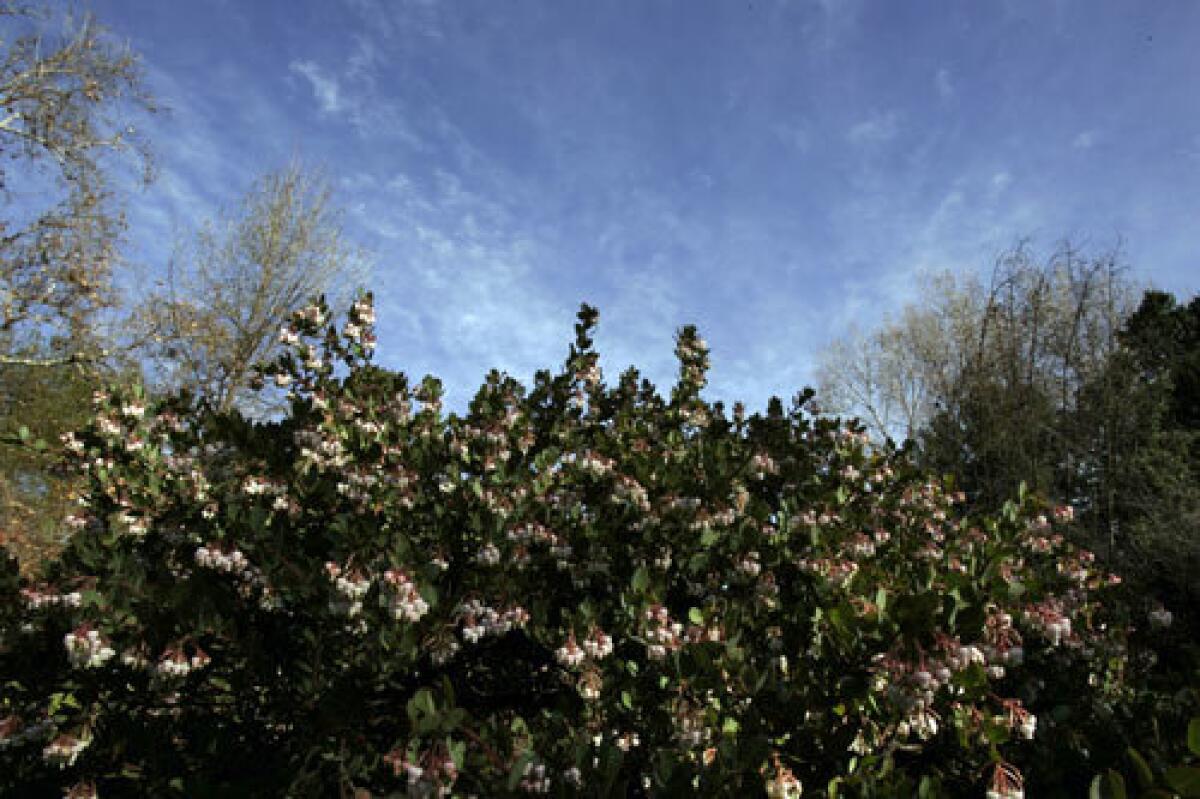Low-maintenance manzanita a favorite in Southern California

- Share via
Now that our new president has called us to service, Southern Californians have another reason to pitch in and avert a looming water crisis. We can do it now, and the first step couldn’t be simpler or cheaper or more beautiful.
Plant manzanita.
In contrast to lawn, manzanita needs little more than an occasional pass with the hose. You’d have to succumb to an epic daydream to create run-off while watering it.
That alone should close the argument. But manzanita is so worthy, only an infomercial format could do justice to its virtues.
First, the plant’s signature gray-green foliage will be erupting in clusters of white and pink flowers through February.
Second, the more manzanita you plant, the lower your water bill goes -- as low as half if you plant it in place of lawn. Do that, and your yard maintenance bill would drop to close to zero.
Do that and suddenly the once-a-week racket of the mow-and-blow team will be history.
Do that and you will be sparing the city from the exhaust of two-stroke lawn mowers.
Do that and even your tax bill might benefit. City haulers will have less green waste to take away.
Most of all, you will be treated to one of the best shows that California native flora has to offer. Manzanita needn’t cover your whole yard to gain the benefits of a native garden, but it can. Or it can create the bones for a garden.
Bart O’Brien, director of special projects at Rancho Santa Ana Botanic Garden in Claremont, likes everything about manzanita. Being a horticulturist, he calls it by its botanical name, Arctostaphylos, “Arcto” for short.
“The plants look great year round,” he says. “Arctos have no down season at all. I like the flowers, the fruit, the foliage and the bark is great.”
Ask plants-man Mike Evans from the Tree of Life Nursery in San Juan Capistrano what he likes about manzanitas, and his mind turns instantly to their diversity, more than 200 types of species and cultivars.
Although many of Southern California’s winter-flowering garden plants such as citrus and jasmine put out buds that tease us for days, even weeks, there’s a startling suddenness to the way various manzanitas seem to erupt into bloom this time of year with clusters of tiny, bell-shaped flowers.
These honey-scented blossoms have such high-class nectar, by early spring enough bees and hummingbirds will have pollinated them that fruits will have formed. The plants will be bedecked by the rosy little fruits that gave rise to the name manzanita, Spanish for “little apple.”
These little apples are so high in pectin, O’Brien says, that Native Americans chewed on them to stave off dehydration. But soon they become so hard that it would take a fire or passage through a coyote’s or bird’s digestive track to soften them up for easy germination.
That’s another virtue: With such challenging seeds, manzanitas do not tend to produce volunteers, meaning they are not invasive.
Incredibly, none of these factors -- their fruit, their fragrance, their flowers -- are manzanitas’ most striking aspect. That would be the combination of the curling shape of its branches and its bark.
Manzanita has some of the best bark in bark-dom, sometimes a lustrous, smooth mahogany color, or a deep Tudor brown, or purple, pink or tan. As the plant begins to grow in spring and stems swell, the bark will curl off in dramatic, deep-hued shavings. At the finish of this spectacular shedding, the plant will enter summer dormancy.
Throughout this down-time, the leaves remain lustrous and sturdy, and they come in a palette that would give rise to plein-air painting. Pioneer native gardener Lester Rowntree remarked that manzanita leaves “look like they’re listening.”
They’re listening to the sun, O’Brien says.
“Arctostaphylos leaves tend to be held perpendicular to the noonday sun,” he says. “It’s a water-conservation and temperature-controlling device. If they’re not getting direct sun, they’re not transpiring and losing moisture through photosynthesis.”
This means they hold the light differently. They shimmer. If there’s a drawback to the lovely posture of the leaves, it’s that it can make it hard to read when they need water.
“They don’t wilt,” says O’Brien. “They can’t wilt. Only new growth can sometimes flag. During the summer months you have to be tuned into what the manzanita is telling you. If they’re borderline, they’ll go off color. If they don’t get water then, a branch can die.”
Throughout our long, hot summers, he recommends occasional showers. This is largely to clean smog from the leaves, and O’Brien cautions against the kind of drenching that would yank them from dormancy when they would be better off sleeping out summer heat.
Manzanitas’ final asset, the thing that makes them so self-sufficient, is that they are slow growing and long lived. Don’t be depressed if they don’t do too much the first couple of years, Evans says, “as long as they’re not dying.”
But even this reticence is a virtue. Invest once and you’re done. As long as you don’t crowd them with faster-growing plants, they can go years with little pruning except artistic nips to better reveal their glorious bark.
More to Read
Sign up for The Wild
We’ll help you find the best places to hike, bike and run, as well as the perfect silent spots for meditation and yoga.
You may occasionally receive promotional content from the Los Angeles Times.










